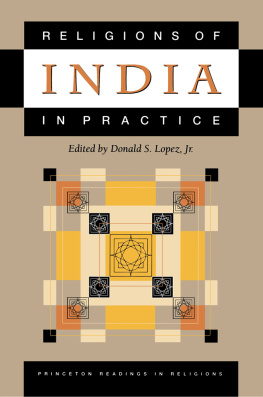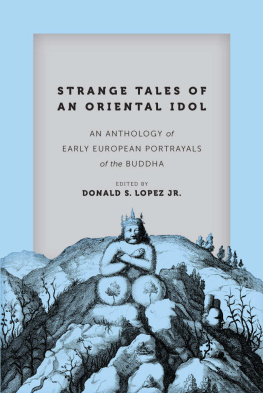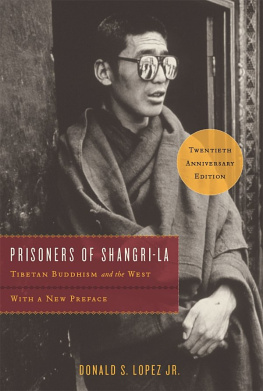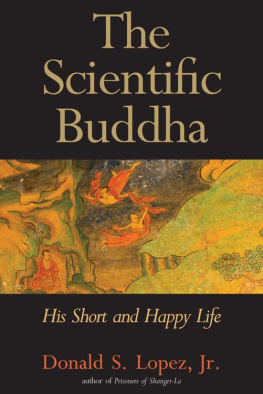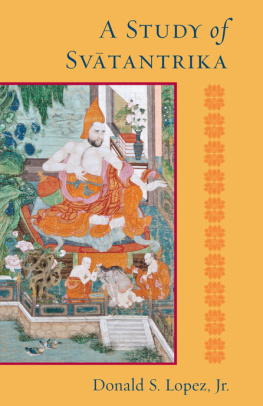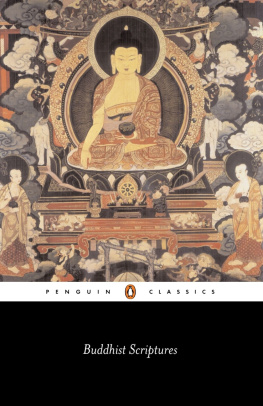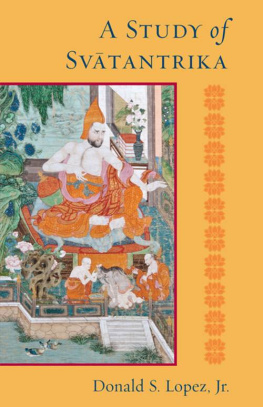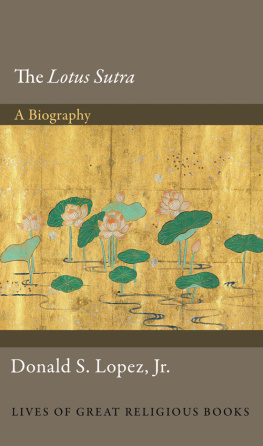TWO BUDDHAS
Seated Side by Side
Two Buddhas
Seated Side by Side

A GUIDE TO THELOTUS STRA
Donald S. Lopez Jr. and Jacqueline I. Stone
Princeton University Press
Princeton& Oxford
Copyright 2019 by Princeton University Press
Published by Princeton University Press
41 William Street, Princeton, New Jersey 08540
6 Oxford Street, Woodstock, Oxfordshire OX20 1TR
press.princeton.edu
All Rights Reserved
Library of Congress Control Number: 2019942250
First paperback printing, 2021
Paper ISBN 978-0-691-22794-8
Cloth ISBN 978-0-691-17420-4
ISBN (e-book) 978-0-691-18980-2
Version 1.0
British Library Cataloging-in-Publication Data is available
Editorial: Fred Appel, Thalia Leaf, and Jenny Tan
Production Editorial: Kathleen Cioffi
Text and Jacket/Cover Design: Leslie Flis
Production: Erin Suydam
Publicity: Tayler Lord and Kathryn Stevens
Jacket/Cover image: The Buddhas Prabhutaratna and Sakyamuni seated side by side. Courtesy of the Freer|Sackler, Smithsonian
Printed in the United States of America
Contents
- ix
- xi
- CHAPTER ONE:
Introduction - CHAPTER TWO:
Skillful Means - CHAPTER THREE:
A Parable - CHAPTER FOUR:
Willing Acceptance - CHAPTER FIVE:
Herbs - CHAPTER SIX:
Prediction - CHAPTER SEVEN:
The Apparitional City - CHAPTERS EIGHT AND NINE:
The Five Hundred Disciples Receive Their Predictions and The Predictions for Those Who Still Have More to Learn and for Those Who Do Not - CHAPTER TEN:
Expounder of the Dharma - CHAPTER ELEVEN:
The Appearance of the Jeweled Stpa - CHAPTER TWELVE:
Devadatta - CHAPTER THIRTEEN:
Perseverance - CHAPTER FOURTEEN:
Ease in Practice - CHAPTER FIFTEEN:
Bodhisattvas Emerging from the Earth - CHAPTER SIXTEEN:
The Lifespan of the Tathgata - CHAPTERS SEVENTEEN AND EIGHTEEN:
Description of Merits and The Merits of Joyful Acceptance - CHAPTER NINETEEN:
The Benefits Obtained by an Expounder of the Dharma - CHAPTER TWENTY:
Bodhisattva Sadparibhta - CHAPTERS TWENTY-ONE AND TWENTY-TWO:
The Transcendent Powers of the Tathgata and Entrustment - CHAPTER TWENTY-THREE:
Ancient Accounts of Bodhisattva Bhaiajyarja - CHAPTERS TWENTY-FOUR AND TWENTY-FIVE:
Bodhisattva Gadgadasvara and The Gateway to Every Direction - CHAPTER TWENTY-SIX:
Dhra - CHAPTER TWENTY-SEVEN:
Ancient Accounts of King ubhavyha - CHAPTER TWENTY-EIGHT:
Encouragement of Bodhisattva Samantabhadra
Acknowledgments
No book is completed without the support of many people. We would like first to thank our two manuscript readers and others for their valuable suggestions and criticisms. Advice from Daniel B. Stevenson in particular substantially improved the book. Any errors are, of course, our own. We thank Fred Appel, our executive editor at Princeton University Press, as well as others at the press who helped in the production process, including our editorial assistant, Thalia Leaf, and our production editor, Kathleen Cioffi. We would also like to acknowledge our copy editor, Susan Rescigno. Special thanks are due to the temple Myhonji in Kamakura, for permission to reproduce the photo of Nichirens maala that appears as the frontispiece to the print editions of this volume. Our appreciation also goes to Mary Mortensen, who compiled the index. Both of us, the authors, teach the Lotus Stra in our classes on Buddhism. Our final thanks go to our students, whose questions and responses to the Lotus have stimulated our thinking about the stra and helped inspire this volume.
A Note on Sources
All quotations from the Lotus Stra are taken from the translation done by Tsugunari Kubo and Akira Yuyama. See The Lotus Stra, rev. 2nd ed., trans. by Tsugunari Kubo and Akira Yuyama, BDK English Tripiaka Series (Berkeley: Numata Center for Buddhist Translation and Research, 2007). For the readers convenience, we have provided in-text page references to this translation after each quotation. Please note that the pagination of the printed version of the text (used here) differs from the pagination of the version presently available online.
Kubo and Yuyama based their translation on the celebrated Chinese version of the stra produced by the Central Asian scholar-monk Kumrajva in 406. In several places, however, they chose not to follow traditional Sino-Japanese interpretation but have instead consulted the Sanskrit and, in a few instances, the Tibetan versions of the Lotus (see their Translators Introduction, xiv). One way in which their English version departs from Kumrajvas Chinese lies in the handling of proper names. Where Kumrajva translated many names of figures appearing in the Lotus Stra, Kubo and Yuyama give them in the original Sanskrit. We have followed suit, not to give primacy to the Sanskrit text, but for consistency with the Kubo-Yuyama translation. However, some of the longer Sanskrit names can prove daunting to readers unfamiliar with that language. We have accordingly provided in parentheses with the first occurrence of such names the English rendering given by Leon Hurvitz in his translation of the Lotus Stra: Scripture of the Lotus Blossom of the Fine Dharma (the Lotus Stra), published by Columbia University Press (1976; rev. 2009), or a translation of our own.
We have rendered the daimoku, the invocation of the Lotus Stras title taught by Nichiren, as Namu Myh-renge-ky, which represents the proper romanization for scholarly writing. However, actual pronunciation may vary slightly according to the practice community; some groups collapse the second and third syllables, giving Nam Myh-renge-ky (sometimes written without diacritics in their publications). The difference is not one of correct versus incorrect but simply reflects variations among the traditions of individual Nichiren Buddhist lineages.
Two extensive collections of Nichirens writings have appeared in English translation, both intended for practitioners. One, supervised by Kyts Hori with the assistance of other translators and editors, is Writings of Nichiren Shnin (20032015), now numbering seven volumes, published by the Nichirensh Overseas Propagation Promotion Association (NOPPA). At the time of this writing, limited previews of two of these volumes are available at Google Books. A second collection of Nichirens works in English is the two-volume Writings of Nichiren Daishonin, translated by the Gosho Translation Committee and published by Ska Gakkai. The entirety of this translated collection is available online as a searchable database (http://www.sgilibrary.org/writings.php). During much of the translation process, Ska Gakkai had the assistance of the late Burton Watson, professor emeritus of Columbia University and an accomplished translator of Chinese and Japanese literature. Two volumes of these translations, edited by Watsons colleague, the late Philip Yampolsky, have also been published by Columbia University Press. In translating passages from Nichirens writings for this volume, we have referred to existing translations and sometimes followed them quite closely. Often, however, we have modified them either to meet the demands of the present study (for example, to bring terminology in line with the Kubo and Yuyama


